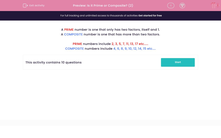A PRIME number is one that only has two factors, itself and 1.
A COMPOSITE number is one that has more than two factors.
PRIME numbers include 2, 3, 5, 7, 11, 13, 17 etc.....
COMPOSITE numbers include 4, 6, 8, 9, 10, 12, 14, 15 etc....

In this worksheet, students decide whether or not a given number is prime or composite.
This content is premium and exclusive to EdPlace subscribers. Sign up now.

Key stage: KS 2
Year: Year 5 11+ worksheets
Curriculum topic: Maths and Numerical Reasoning
Curriculum subtopic: Special Numbers
Difficulty level: 


We're your National Curriculum aligned online education content provider helping each child succeed in English, maths and science from year 1 to GCSE. With an EdPlace account you’ll be able to track and measure progress, helping each child achieve their best. We build confidence and attainment by personalising each child’s learning at a level that suits them.
Get started
Try an activity or get started for free



